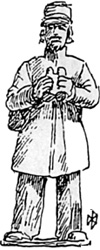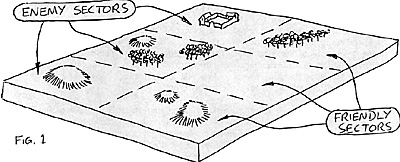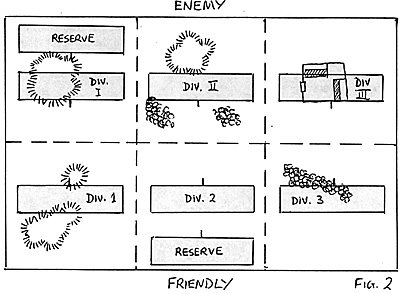Introduction
 These rules were developed to simulate the battlefield orders written by an opposing general during a wargame. The aim of these rules is to provide an automated opponent for a solo wargamer enabling him or her to focus on controlling one army. These rules were designed for 19th Century European battle simulations and the more detailed tactical formations are aimed at this period. However, the basic concept could be adapted to Ancient or Modern periods through modification to the details given in the divisional orders.
These rules were developed to simulate the battlefield orders written by an opposing general during a wargame. The aim of these rules is to provide an automated opponent for a solo wargamer enabling him or her to focus on controlling one army. These rules were designed for 19th Century European battle simulations and the more detailed tactical formations are aimed at this period. However, the basic concept could be adapted to Ancient or Modern periods through modification to the details given in the divisional orders.
-
The Battlefield First establish battlefield terrain features. Split the battlefield into six parts; three parts occupied by the enemy force and three parts occupied by your troops (see figure 1). Now designate each of the six parts as being open, hilly, wooded or fortified. Where there is a mixture of terrain features fortified dominates, followed by woods and then hills. E.g. if a part of the battlefield contains fortified hills then it is considered fortified. Wooded hills will be considered as wooded terrain. Note that forts can include walled farmyards, villages, earthworks as well as redoubts and castles.
Offensive or Defensive Initially decide whether your army will be on the offensive or defensive and then establish the enemy's aim; attacking or defending. To make the choice for the enemy army I look at the campaign situation that created the battle. This will provide an immediate answer or at least establishes the chances one way or another to be decided by a dice throw.
Order of Battle Next the player lays out the friendly forces on the battlefields. The enemy forces can now be arranged. Split the opposing force into four divisions. One division is placed in each of the enemy's three battlefield sectors. The fourth division will form the reserve and its location is established using the following technique.
The terrain in each of the enemy's battlefield sectors is compared to the terrain opposite each of them into which they will attack or from which they will receive an attack. For each of the enemy's sectors a terrain factor is given to which modifiers are added or subtracted. The lower the terrain factor, the easier it is to attack from that region and the harder it is to defend that region.
Enemy Terrain Factors
| Terrain | Enemy Orders | |
|---|---|---|
| Offensive | Defensive | |
| Open Terrain | 2 | 1 |
| Hilly Terrain | 1 | 2 |
| Wooded Terrain | 3 | 3 |
| Fortified Terrain | 2 | 4 |
Modifiers:
- +1 if the terrain opposite is hilly
+2 if the terrain opposite is wooded
+3 if the terrain opposite is fortified
+1 for a D6 score of 3 or 4
+2 for a D6 score of 5 or 6
 The enemy is on the defensive.
The enemy is on the defensive.
Its right wing is in hilly terrain (terrain factor = +2), opposite is more hilly terrain (+1) and a die score of 1 is thrown (0). So the enemy's right wing terrain factor is 2+1+0 = 3.
For the enemy centre there are hills and woods which makes it wooded terrain (+3), opposite is open ground (+0) and a die score of 5 is thrown (+2) = 5.
For the enemy left there is a terrain factor of 7: fortified (+4), opposite wooded (+2), die score of 4 (+1).
 The lowest terrain factor always attracts the reserves; in the example it is the enemy right. Where two sectors have the same lowest terrain factor there are three options:
The lowest terrain factor always attracts the reserves; in the example it is the enemy right. Where two sectors have the same lowest terrain factor there are three options:
- Both areas get half the reserves.
- Decide which area gets the reserves with a dice throw.
- The reserves are located in a position so they can be moved to either of the claiming areas. Whichever area requires them first during the battle can claim them.
4. Divisional Orders
Divisional orders must first be written for the army the player will command. With this done the divisional orders for the enemy can be worked out. For each enemy division throw 1D6 to find the random factor.
Random factor:
- A die score of 1 or 2 gives a random factor of 1
A die score of 3 or 4 gives a random factor of 2
A die score of 5 or 6 gives a random factor of 3
Now work out the support factor for each of the enemy divisions by totalling the factors shown below:
Support Factors:
- +1 if the division is in open terrain and on the defensive.
+2 if the division is in hilly terrain and on the defensive.
+2 if the division is in wooded terrain.
+2 if the division is in fortified terrain and on the offensive.
+3 if the division is in fortified terrain and on the defensive.
-1 if the division to the left has successfully attacked.
-1 if the division to the right has successfully attacked.
-1 if supported by a reserve division to the rear.
Finally work out the opposition factor for each of the enemy divisions, which is again worked out by totalling the factors. Note that when working out these factors you are examining the terrain and troops directly opposite to the enemy division on the battlefield.
Opposition Factors:
- +1 if opposed by a force 150% as big as the division.
+2 if opposed by a force 200% as big as the division.
+4 if opposed by a force 300% as big as the division.
-1 if opposed by a force 75% as big as the division.
-2 if opposed by a force 50% as big as the division.
-3 if opposed by a force 25% as big as the division.
-4 if opposed by a force 10% as big as the division.
+1 per insecure flank i.e. flank under attack or occupied by opposing forces.
+2 if the rear of the division is insecure.
+1 if the terrain opposite is hilly.
+2 if the terrain opposite is wooded.
+3 if the terrain opposite is fortified.
The divisional order code can now be calculated:
- Divisional order code = Random Factor + Support Factor + Opposition Factor.
E.g. Figure 2 shows a battlefield with divisions in position. The enemy forces are on the defensive. Enemy Division I is considered along with the reserve which is supporting it.
Random Factor: Die score of 3 (2 points)
Support Factor: +2 for hilly terrain. -1 for being supported by the division to the rear (1 point)
Opposition Factor: -2 as opposed by a force 50% as big as the division'. +1 as the terrain opposite is hilly. (-1 point).
I Division Order Code = 2 + 1 – 1 = 2
Division order codes can now be converted to orders using the following details. For the example, I division has an order code of 2 and will undertake a moderate attack.
Division Order Code 1 (or less): Major and rapid attack.
75% - 100% of division to engage, the remainder in reserve/support role.
Infantry: To form into rapid movement formations and charge enemy positions.
Cavalry: To form into rapid movement formations and attack weak/weakening spots in the enemy line.
Artillery: To form into massed batteries and bombard enemy strong points.
Division Order Code 2: Moderate attack.
50% - 75% of division to engage, the remainder in reserve/support role.
Infantry: To form into a mix of rapid movement and effective fire formations.
Cavalry: To form into rapid movement formations and support attempted breakthroughs.
Artillery: Some to accompany the advance and support attack at close range. The remainder to support the attack from a distance engaging strong points in the enemy line.
Division Order Code 3: Limited attack.
25% - 50% of division to engage, the remainder in reserve/support role.
Infantry: To form into effective fire formations and advance on the enemy.
Cavalry: To form into rapid movement formations and advance on the enemy. If an opportunity to break through occurs, exploit it otherwise withdraw and repeat operation later.
Artillery: Support the attack from a distance focusing on enemy strong points.
Division Order Code 4: Aggressive skirmishing.
25% - 50% of division to form skirmish line, the remainder in reserve/support role.
Infantry: To form into a skirmish line and attempt to push back the enemy line by firepower.
Cavalry: Probe for weak points with open formations.
Artillery: To support attack and focus on enemy's massed formations.
Division Order Code 5: Hold defensive line and probe enemy line.
10% - 25% of division to form advanced skirmish line, the remainder to occupy defensive positions.
Infantry: Skirmish line to probe enemy lines and advance on weak areas. Defensive line to hold any enemy attacks.
Cavalry: To form up in reserve and exploit enemy defeats.
Artillery: Distributed along defensive line, to focus on any enemy attacks.
Division Order Code 6: Hold defensive line.
50% - 75% of division to form the defensive line, the remainder in reserve/support role.
Infantry: Defensive line to resist all attacks. Reserves to support areas of defensive line under most pressure.
Cavalry: To form up in rear and attack any enemy breakthrough.
Artillery: Distributed along defensive line. Focus on enemy attacks and massed formations.
Division Order Code 7: Delay enemy advance.
25% - 50% of division to form the defensive line, the remainder in reserve.
Infantry: To form the defensive line, reserves to counter attack any breakthroughs but to retreat if counter attacks fail.
Cavalry: To form up in reserve, support counter attacks and cover any retreats.
Artillery: To form batteries in reserve and support counter attacks on breakthroughs. Retreat if threatened.
Division Order Code 8: Interfere with enemy advance.
10% - 25% of division to form the defensive line, the remainder in reserve.
Infantry: Line defences. If a breakthrough is achieved by the enemy conduct an orderly retreat covered by and followed by the reserves.
Cavalry: Cover any retreat of forces.
Artillery: In reserve to assist in covering retreat. Withdraw if threatened.
5. Battle
The wargame can now be fought out. The orders written by the player and the opposing generated orders must be followed as closely as possible. I suggest there be one or two opportunities to change orders at pre-designated times (e.g. after move 5 and 10). At these times the player can write out new orders if required and all enemy divisional orders are reassessed based on the new situation and with a new random factor.
Conclusion
I have enjoyed developing and using these ideas as they have created some challenging battles. Around this basic set of rules it is possible to include a whole range of situations to add to the confusion and unexpected that can turn our wargames into a more realistic battlefield command experience.
Some more ideas experimented with are:
New orders being delayed or failing to be delivered or even delivered to the wrong division!
Unexpected opportunity for enemy divisions to change order codes.
Divisional order codes affected by divisional commander's ability and character.
Digitized by Kenn Hart
Back to Table of Contents -- Lone Warrior #130
Back to Lone Warrior List of Issues
Back to MagWeb Magazine List
© Copyright 2000 by Solo Wargamers Association.
This article appears in MagWeb (Magazine Web) on the Internet World Wide Web.
Other military history articles and gaming articles are available at http://www.magweb.com
